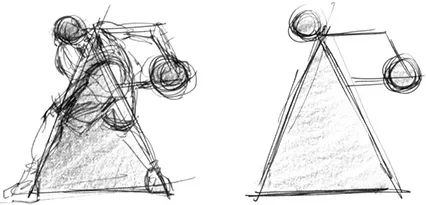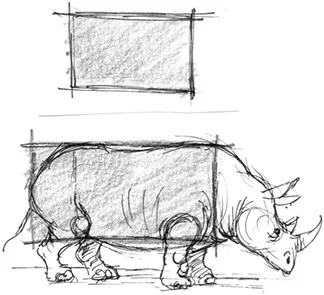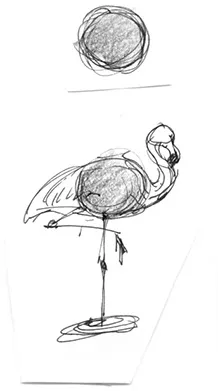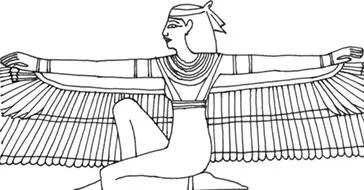
- 408 pages
- English
- ePUB (mobile friendly)
- Available on iOS & Android
eBook - ePub
About this book
Quick Sketching with Ron Husband offers instruction to quick sketching and all its techniques. From observing positive and negative space and learning to recognize simple shapes in complex forms to action analysis and using line of action, this Disney legend teaches you how to sketch using all these components, and how to do it in a matter of seconds. Watch his drawings as he grows from a young, talented artist, to a true Disney animator. Follow him as he goes around the world and sketches flamenco dancers, football players, bakers, joggers, lions, tigers, anyone, and anything.
Key Features
Frequently asked questions
Yes, you can cancel anytime from the Subscription tab in your account settings on the Perlego website. Your subscription will stay active until the end of your current billing period. Learn how to cancel your subscription.
No, books cannot be downloaded as external files, such as PDFs, for use outside of Perlego. However, you can download books within the Perlego app for offline reading on mobile or tablet. Learn more here.
Perlego offers two plans: Essential and Complete
- Essential is ideal for learners and professionals who enjoy exploring a wide range of subjects. Access the Essential Library with 800,000+ trusted titles and best-sellers across business, personal growth, and the humanities. Includes unlimited reading time and Standard Read Aloud voice.
- Complete: Perfect for advanced learners and researchers needing full, unrestricted access. Unlock 1.4M+ books across hundreds of subjects, including academic and specialized titles. The Complete Plan also includes advanced features like Premium Read Aloud and Research Assistant.
We are an online textbook subscription service, where you can get access to an entire online library for less than the price of a single book per month. With over 1 million books across 1000+ topics, we’ve got you covered! Learn more here.
Look out for the read-aloud symbol on your next book to see if you can listen to it. The read-aloud tool reads text aloud for you, highlighting the text as it is being read. You can pause it, speed it up and slow it down. Learn more here.
Yes! You can use the Perlego app on both iOS or Android devices to read anytime, anywhere — even offline. Perfect for commutes or when you’re on the go.
Please note we cannot support devices running on iOS 13 and Android 7 or earlier. Learn more about using the app.
Please note we cannot support devices running on iOS 13 and Android 7 or earlier. Learn more about using the app.
Yes, you can access Quick Sketching with Ron Husband by Ron Husband in PDF and/or ePUB format, as well as other popular books in Art & Art Techniques. We have over one million books available in our catalogue for you to explore.
Information

1 The Basics
My definition of a “true” quick sketch is simply “a sketch done quickly” (i.e., an image captured from a live object on paper in about twenty to thirty seconds). My quick sketches differ from typical classroom quick sketch/gesture drawings that are usually done in one- to two-minute poses by a still or posed model. Typically, “built in” to the models’ poses are balance, perspective, proportion, silhouette, etc. for the duration of the pose. Most models work hard to give the artist the best poses possible and the results are “frozen in time” for the artist to capture everything on paper.
It is my belief that in order to capture a true quick sketch, one must also capture the action seen with the eye. The eye then relays what was observed to the brain and is coupled with real life observations, action analyses, photographs, books read, and any other tips of wisdom from past and present art instruction, and flows out the end of one’s pen or pencil. This goes beyond drawing a “posed pose” to capturing on paper what was there, never to be repeated again in the same way.
Therefore, quick sketches should depict plainly and without question what is going on; the who, what, when, where, why, and how. It may not necessarily answer the when or where, but one look should tell you who (male, female, young, or old), what the captured subject is doing, and how it’s being done. This practice has led to my lifelong love affair with quick sketching. My sketchbook is so much a part of me I feel I’m not fully dressed unless I have my sketchbook in hand.
What Motivates You?
Find something you love to draw: men, women, older men, older women, children, jockeys, horses; you name the living subject and you can take a lifetime observing them. Because they are living and breathing, they will all walk, run, crawl, jump, or drag along in a variety of ways depending on location, motivation, and any other factors that happen at a particular moment in time. Houses, man-made objects, bowls of fruit, etc. can be drawn or painted in marvelous ways and they will always be there in the same lifeless way until some outside force moves them. Living humans and animal life are constantly animating “a life story,” waiting to be stamped on paper by your pen or pencil.
Simple Shapes
Think of the subject in simple shapes. Observe the objects around you: tables, chairs, televisions, books, etc. all consist of shapes—circles, ovals, squares, rectangles, or some combination of these basic shapes.

Can you see the shape in your subjects?

Tip 1
I use an assortment of different sketchpads. My everyday sketchpad is 8½ by 11 inches and ranges from inexpensive paper to a more expensive acid-free, white stock pad. When I am going to a formal gathering a regular pad of paper would look out of place (such as a formal wedding or retirement party) so I use an 8½ by 6 inch fine leather-bound book.
I also like to use a black ink pen. I’ve tried other pens but the Pilot V5 gives me a nice thin line without smearing or running.
Once I have my paper and pen ready, I usually sit down and do some practice drawings. (I think about the basic shape: circle, triangle, square, or rectangle).



People and animals are made up of similar shapes, with smooth edges; so again, look for these basic shapes in the objects you draw.
Observing these shapes in your subjects helps develop “an eye” for making identifiable shapes quickly. Remember, we are laying the foundation for quick sketching. Observation is key to analyzing any action or activity. Making mental notes of how someone does a specific action pays dividends when it is time to put pencil to paper. Artists must become people watchers; recognizing the differences in those who make up the human race. As bird watchers note the peculiarities of how one species of fowl behaves juxtaposed to another, we’re drawn to the realization that there are as many ways of doing things (i.e., walking, standing, gesturing, etc.) as there are people on the face of the earth.
Body Types
There are as many different body types in humans (and animals) as there are individuals on this planet. The one you choose to commit to paper must convey enough information to tell the viewer who it is, their age, what they are doing, and take into account any interesting body characteristics.
The ancient Egyptian artists were greatly aware of giving the most information possible to the viewer. By looking at most two-dimensional Egyptian artwork, it is not uncommon to see a straight-on eye in a profile head. This gives more information about the eye than a side view can and the profile head gives more information than a straight-on view of the head. For example, the straight-on head cannot tell you the shape of the nose or how far the brow hangs over the eyes or the shape of the chin. By using a straight-on view of the upper torso, combined with a profile of both legs, the ancient artist has attempted to provide us with the greatest amount of information about the figure.

Quick sketching is an attempt to get this kind of information on paper in as short a time as possible and have a drawing that conveys enough information to be easily recognizable; a sizeable task, but one...
Table of contents
- Cover
- Half Title
- Title Page
- Copyright Page
- Table of Contents
- Foreword
- Preface
- Acknowledgments
- Introduction
- 1. The Basics
- 2. Analysis of Action
- 3. Everyday Activities
- 4. The Art of Sitting
- 5. Table Games
- 6. Standing with Attitude
- 7. Walking with Style
- 8. Children
- 9. Special Occasions
- 10. Music, Dancing, and Singing
- 11. The Zoo
- 12. Individual Sports
- 13. Team Sports
- 14. Quick Sketching Around the World
- 15. Winter Sports
- 16. Sketching Multiple Characters
- Index